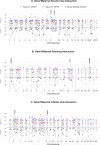Evidence for gene-environment interaction in a genome wide study of nonsyndromic cleft palate
- PMID: 21618603
- PMCID: PMC3180858
- DOI: 10.1002/gepi.20595
Evidence for gene-environment interaction in a genome wide study of nonsyndromic cleft palate
Abstract
Nonsyndromic cleft palate (CP) is a common birth defect with a complex and heterogeneous etiology involving both genetic and environmental risk factors. We conducted a genome-wide association study (GWAS) using 550 case-parent trios, ascertained through a CP case collected in an international consortium. Family-based association tests of single nucleotide polymorphisms (SNP) and three common maternal exposures (maternal smoking, alcohol consumption, and multivitamin supplementation) were used in a combined 2 df test for gene (G) and gene-environment (G × E) interaction simultaneously, plus a separate 1 df test for G × E interaction alone. Conditional logistic regression models were used to estimate effects on risk to exposed and unexposed children. While no SNP achieved genome-wide significance when considered alone, markers in several genes attained or approached genome-wide significance when G × E interaction was included. Among these, MLLT3 and SMC2 on chromosome 9 showed multiple SNPs resulting in an increased risk if the mother consumed alcohol during the peri-conceptual period (3 months prior to conception through the first trimester). TBK1 on chr. 12 and ZNF236 on chr. 18 showed multiple SNPs associated with higher risk of CP in the presence of maternal smoking. Additional evidence of reduced risk due to G × E interaction in the presence of multivitamin supplementation was observed for SNPs in BAALC on chr. 8. These results emphasize the need to consider G × E interaction when searching for genes influencing risk to complex and heterogeneous disorders, such as nonsyndromic CP.
© 2011 Wiley-Liss, Inc.
Figures




References
-
- Ghassibe M, Desmyter L, Langenberg F, Claes O, Boute B, et al. Am Hum Genet. 2010. FAF1, the first gene associated with cleft palate. in press.
Publication types
MeSH terms
Substances
Grants and funding
- U01-DE-018993/DE/NIDCR NIH HHS/United States
- U01 DE018993/DE/NIDCR NIH HHS/United States
- R01-DE-0106877/DE/NIDCR NIH HHS/United States
- R01 DE016148/DE/NIDCR NIH HHS/United States
- R01-DE-016148/DE/NIDCR NIH HHS/United States
- ImNIH/Intramural NIH HHS/United States
- R21 DE016930/DE/NIDCR NIH HHS/United States
- U01 DE020057/DE/NIDCR NIH HHS/United States
- R37 DE008559/DE/NIDCR NIH HHS/United States
- U01 HG004446/HG/NHGRI NIH HHS/United States
- R21-DE-016930/DE/NIDCR NIH HHS/United States
- R01-DE-012472/DE/NIDCR NIH HHS/United States
- R01 DE014581/DE/NIDCR NIH HHS/United States
- U01-DE-020057/DE/NIDCR NIH HHS/United States
- P50-DE-016215/DE/NIDCR NIH HHS/United States
- R01-DE-014581/DE/NIDCR NIH HHS/United States
- P50 DE016215/DE/NIDCR NIH HHS/United States
- R01-DE-09886/DE/NIDCR NIH HHS/United States
- R01 DE009886/DE/NIDCR NIH HHS/United States
- R37-DE-08559/DE/NIDCR NIH HHS/United States
- R37-DE-0-8559/DE/NIDCR NIH HHS/United States
LinkOut - more resources
Full Text Sources
Medical
Molecular Biology Databases
Miscellaneous

